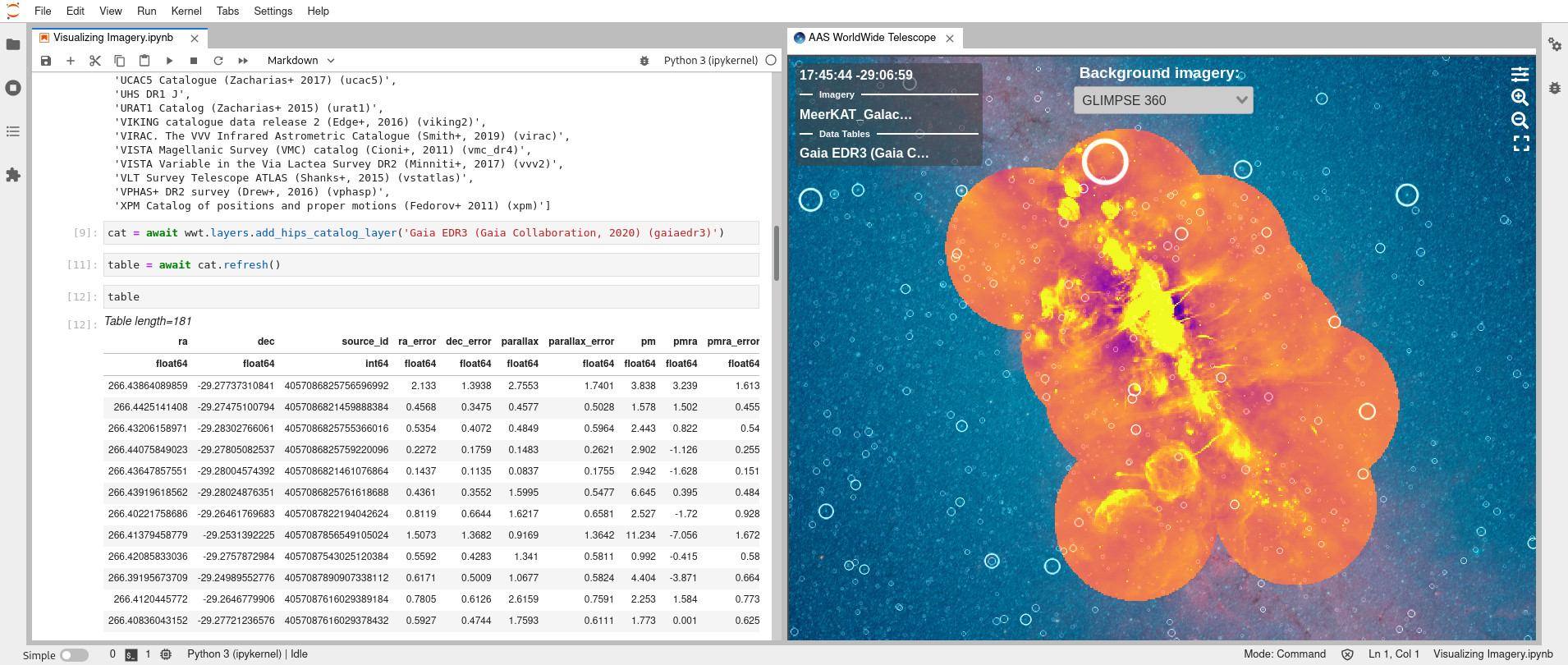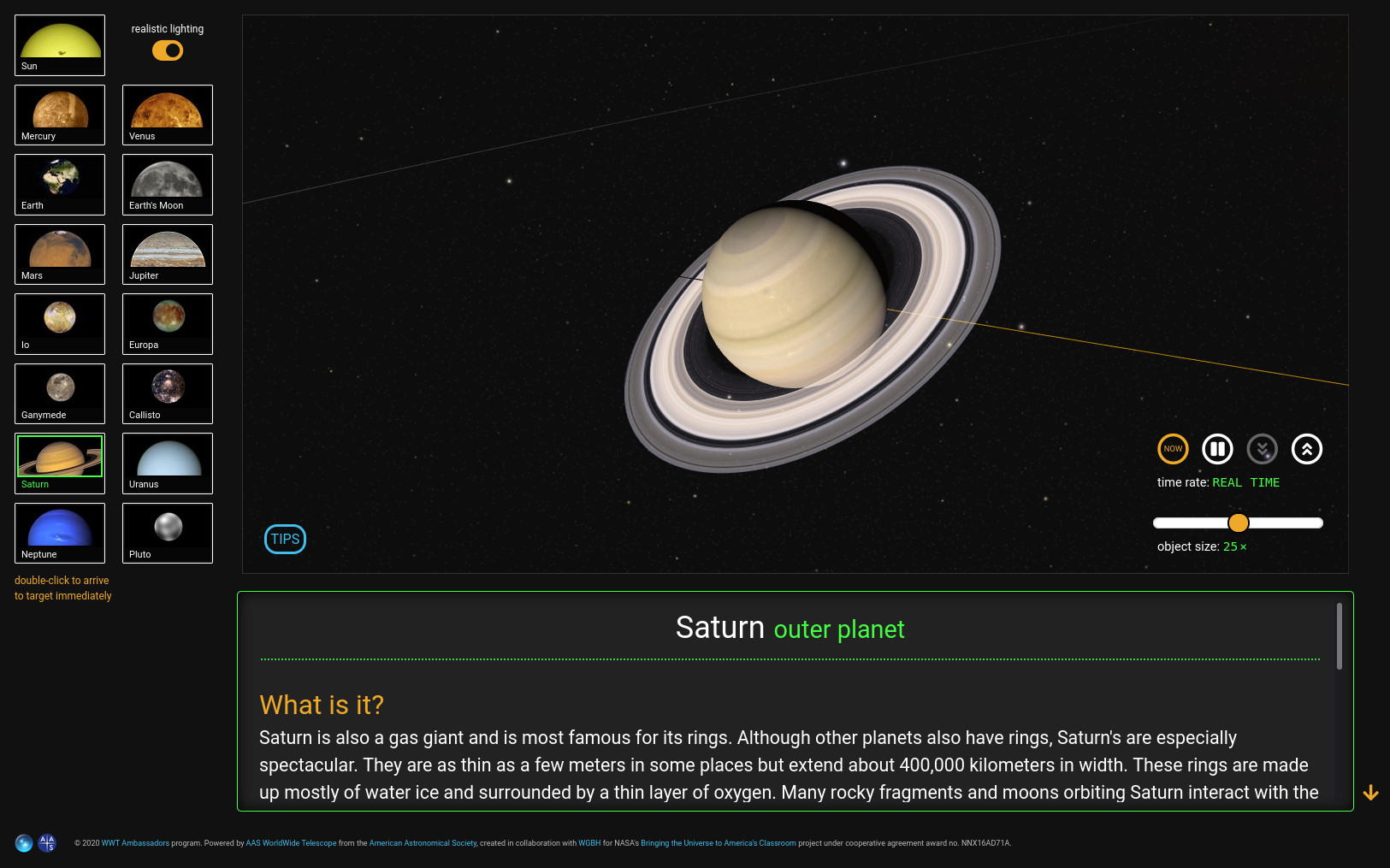WWT 2022
The 2022 edition of AAS WorldWide Telescope launched on February 15th, 2022.
WWT isn’t a physical telescope — it’s a suite of free and open source software and data sets that combine to create stunning scientific visualizations and stories. While WWT started out as a standalone Windows application, it’s evolved into a powerful astronomy visualization toolkit that you can use on the desktop, in the browser, and from Python. To learn more, visit the WWT homepage.
An “edition” is a coordinated release of the many software and data components that comprise the WWT ecosystem. This edition homepage covers:
- What’s New
- See WWT 2022 In Action
- Get Started with WWT 2022
- Release Notes
- Donate to WWT
- Additional Resources
What’s New
So many things! WWT 2022 wraps up several years’ worth of improvements to all aspects of WWT. Watch the official WWT 2022 launch video or read the AAS press release for an overview. The highlights include:
- A new WWT “research app” for seamlessly integrated data analysis and visualization in JupyterLab
- New support for HiPS imagery and catalogs
- A new system for “tiling” FITS datasets to allow even gigapixel-scale scientific images to be explored interactively (supported by the NSF)
- A dramatically expanded suite of data tools for converting all kinds of images and datasets into WWT’s formats (partially supported by Space Telescope Science Institute)
- A new stable release of the WWT Windows application
- Literally thousands of beautiful new astronomy images integrated into WWT’s data holdings
- And more!

See WWT 2022 In Action
Here are some great ways to see some of the things that WWT 2022 can do:
- For researchers and other technically-minded folks, you can dive right into our cloud-based tutorial notebooks that demonstrate the usage of the new WWT JupyterLab app.
- Click here to open up a freestanding version of the app to showcase an incredible image of the Milky Way galactic center at radio wavelengths from the MeerKAT telescope (details here)
- The Solar System Explorer is a WWT-powered educational web application created by the WWT Ambassadors group. It didn’t take a team of software engineers to create this — just a pair of astronomer/educators with a keen eye for design and willingness to learn a bit of JavaScript!
- This Sky & Telescope article embeds a WWT “guided tour” to provide an interactive, multimedia tour of the some bright stars in the northern winter night sky.
All of these examples build on the WWT visualization technology that also powers the core WWT web client and Windows client applications.

Get Started with WWT 2022
There’s no one way to “install WWT” because the software spans so many different uses. Here are our recommendations for different kinds of users:
- Researchers: install WWT’s Python modules and Jupyter/JupyterLab extensions
- Enthusiasts: explore the universe with WWT’s web and Windows applications
- Educators: explore WWT educational apps and create your own “guided tours”
- Planetarians: set up WWT in your planetarium or museum
- Image creators: install WWT’s data processing tools
- App developers: start using the WWT toolkit in Python or JavaScript/TypeScript
Release Notes
In these notes you’ll find synthetic discussions of changes in WWT 2022 compared to previous versions.
- Detailed list of WWT 2022 component versions
- Release notes for WWT web applications:
- Release notes for WWT desktop applications:
- Release notes for supporting packages:
To learn about changes to a component of WWT 2022 not listed above, consult its technical changelog as linked from the detailed versions list.
Donate to WWT
As part of the non-profit American Astronomical Society, WWT’s mission is to help scientists and educators showcase astronomical data and knowledge. WWT’s web servers send out gigabytes of data every hour to hundreds of thousands of visitors every year. Your contributions help keep the WWT servers running, delivering beautiful astronomical imagery to users around the world for free, and demonstrate the breadth of the community that values WWT. Please consider donating to WWT and spreading the word!
Click here to donate to WWT now!
Additional Resources
- To stay informed about everything WWT, sign up for the WWT newsletter!
- The WWT Documentation Hub, home to virtually all primary WWT documentation
- People using WWT for research should seek help in the
#wwtchannel of the Astropy Slack workspace. If you’re not already a member, you can get an Astropy Slack account in one simple step. - For other kinds of questions, try the more generalist WWT Forum.